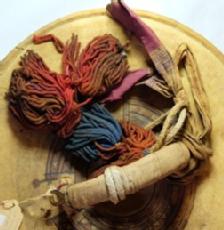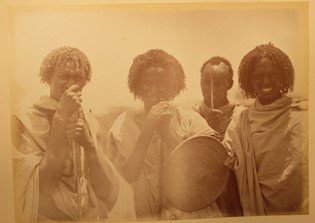The James Collection: Connecting Sussex with Somalia and Sudan through thefts of cooking pots and gifts of cloth
Published: 22 February 2022 - Fleur Martin
How did an arts and conservation college in a remote area of West Sussex come to own potentially the oldest collection of Sudanese ethnographic material in the UK?[i] This blog investigates how the study of a small and little-known collection, acquired by the James brothers in the late nineteenth century, can reveal global entanglements, and tales of conflicting agency between Europe and eastern Africa.
From 1874 to 1890, the three James brothers, Frank, Arthur, and William, used their vast inherited wealth to travel the world, indulging their love of hunting and amateur geography. They were notable to their contemporaries for the unusual caravan trade routes which Frank and William took during the Mahdist era in Sudan from 1881-2, and Somalia from 1884-5.[ii] However, in the twentieth century, they have drifted into obscurity. Travellers like the James’ have primarily been studied as geographical explorers, and their collecting has been marginalised, along with the imperial violence inherent to this behaviour.[iii]
The brothers amassed a collection on their journeys, now housed at West Dean, the Sussex country house brought by William in 1891. Today it is an arts and conservation college; it is not an accredited museum open to the public. West Dean’s collections include surrealist art, European oil paintings, furniture and weapons, Chinese pottery, African weapons, and “everyday” objects, mostly from Sudan and Somalia. The collection is unsystematic and eclectic, recalling the earlier age of ‘curiosity cabinets’ rather than the late nineteenth-century evolutionary displays of ethnographic museums. West Dean has approximately 103 African objects, including weapons, bottles, hats, two Koranic prayer boards, a Jibbah and a drum which purportedly belonged to Osman Digna, the Mahdist revolutionary. Frank wrote two books and left behind 17 volumes of diaries upon his death in 1890, mostly recording their hunting exploits. What happened on the brothers’ journeys, and how does it relate to the collection? They were involved in looting, but how this connects to the collection is not a straightforward tale of artefact theft. Not everything in the collection was looted, but to state that an object was gifted or traded does not mean that it was willingly given, for these travellers were harbingers of imperial violence.
In January 1881, the James’ travelled through a Sudanese village they name as ‘Koolookoo.’ On the hill behind the village they found “cooking-pots, and other valuables, stowed away in holes in the rock; as the natives, when they first decried us, had dragged them up there, fearing we might prove to be enemies.”[iv] There are no cooking pots today in the collection, if there ever were, but this passage shows the fear the brothers’ presence engendered. Moreover, it appears the community at Koolookoo were right to fear that the James party might take their pots, as a few days later at an unnamed, recently abandoned village, Frank wrote, “in the dwellings we found cooking-pots, gourds for drinking, and roughly made wooden bedsteads; our men appropriated some of the cooking-utensils.”[v] Looting was part and parcel of the expedition, but not necessarily for the purpose of creating a collection. Rather, resources were scarce, and their racial prejudice meant they felt no moral compunction against enabling theft from Sudanese villagers.
Trade and agency
Studying trade relations is vital to understanding collecting practices in eastern Africa during the late nineteenth century. Through these relations we can see how eastern African agencies influenced European production lines, from cotton cloth in Manchester, to glass beads in Venice. European and American travellers found that unless they brought objects eastern Africans wanted, they would not only go home collection-less but also could not buy food, water, shelter, or safe passage, unless they resorted to violence.
Obtaining grain en route was vital to the survival of caravans, and the brothers frequently ran into difficulties. Women at Faf, Somalia (now in Ethiopia’s Somali region), in 1884, initially traded their grain for the brothers’ glass beads and bangles, but quickly demanded back their grain, finding the brothers’ goods had no value, being the wrong size, shape or colour.[vi] Travellers like the James’ used their wealth and powerful weaponry to exercise power in exchanges, this is undeniable, but in reading ‘against the archival grain’[vii] it is evident that people also exercised agency in the flow of materialities to and from their homes and markets into European hands. This is particularly true of women, who were often responsible for market trading on the James’ travels. Of course, the threat of imperial violence these visitors embodied complicates this story. Is an exchange really freely undertaken, when one side has tens of men armed with guns, camping outside a village? Women setting up markets outside villages to negotiate trade deals with imperial travellers such as the James’ was arguably not only about furthering their own material interests, but gauging and diffusing threats of violence.
Frank James’ diaries contain many accounts of gifting practices, the brothers brought a “present box” on their travels, filled with everything from jewellery to weapons to cloth.[viii] During their 1881-2 journey through Sudan, Frank wrote “we gave each of the men who came from the village a looking-glass, some prints, needles and cotton thread. […] We regretted, however, that we had not bought more Manchester cotton and beads, as these are things they appreciate more than anything you can give them.”[ix]
He corrected this oversight for their journey through Somalia in 1884-5, where their supplies included “numerous bales of cotton cloth and beads, for presents and for barter.”[x] Cloth was mostly used as a gift for local leaders – as a form of taxation – and beads were used mainly for buying subsistence goods. Many collections from this era contain beadwork and jewellery: that the James’ seem to have collected none, beyond three beads recently found inside a gourd bottle, is curious. The only cloth of potentially European origin in West Dean’s collection is on the back of this Somalian shield. As can be seen, it matches photographs of shields from their travels through a Somalian village. It is one of a set of three, classed by West Dean as “ceremonial shields.”



Figures 1, 2 & 3: Somalian shield, collected in 1884 by the James brothers, and potential previous owner, photographed by William James (1884).
Studying the collection and archives at West Dean, it becomes clear that collecting was a coeval process of loss and accumulation, informed by the motivations of both eastern African communities and European travellers within a context of escalating and brutal imperial violence. In the project “Whose Heritage? Rethinking the West Dean Collection”, West Dean is aiming to improve the curation and care of these objects. By contextualising collections not only within the histories of their collectors, but also broader histories of imperial violence and exchange, heritage institutions are better placed to question the future of their collections, even when empirical provenance data inevitably remains elusive.
Fleur Martin is a PhD student in the History Department, University of Warwick, supervised by Professor David Anderson. She has a background in Anthropology and her thesis is entitled ‘Looting, Trade & The Gift: Imperial Collecting in Eastern Africa, 1860-1914.’
[i] According to an unpublished report for West Dean by JC Niala, September 2020.
[ii] James, J. A., and W. D. James, ‘Obituary: Mr. Frank Linsly James’, Proceedings of the Royal Geographical Society and Monthly Record of Geography, 12.7 (1890), 425–27, p. 425.
[iii] See for instance Brown, M. Where Giants Trod. The Saga of Kenya’s Desert Lake (London: Quiller Press, 1989) & Imperato, P.J. Quest for the Jade Sea: Colonial Competition Around an East African Lake (Oxford: Westview Press, 1998).
[iv] James, F. L., The Wild Tribes of the Soudan: An Account of Personal Experiences and Adventures During Three Winters Spent in That Country Chiefly Among the Bas Tribe (London: J. Murray, 1883), 91.
[v] James, F. L., The Unknown Horn of Africa (London: G. Phelps, 1890), 97.
[vi] James, Unknown Horn, 143.
[vii] Stoler, A. L., Along the Archival Grain: Epistemic Anxieties and Colonial Common Sense (Oxford: Princeton University Press, 2009).
[viii] James, Wild Tribes, 111.
[ix] James, Wild Tribes, 92
[x] James, Unknown Horn, 33.



